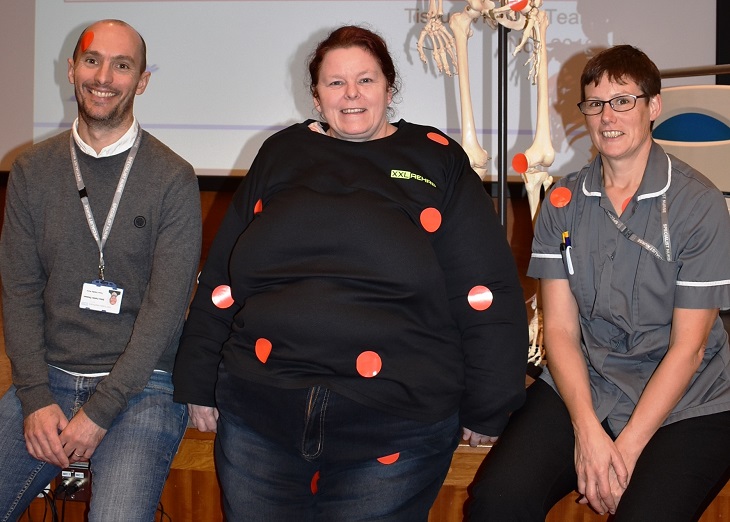The Tissue Viability team at the Trust are supporting International Stop Pressure Ulcers Day, with the aim of increasing awareness of how to prevent pressure ulcers by talking to patients, families and members of the public.

Tissue Viability team supporting International Stop Pressure Ulcers Day with red dots.
The team are handing out red dots to get people to start a conversation about preventing pressure ulcers. A pressure ulcer (sometimes called a bed sore or pressure sore) is when skin and underlying tissue gets damaged by unrelieved pressure causing a painful area/ulcer.
Rachael Stephens, Tissue Viability Nurse, said: “Pressure ulcers are a known problem, which can severely impact on a patient’s quality of life. The majority can be prevented with early identification of risks. It is down to everyone – patients, families, carers and healthcare professionals – to help prevent them from occurring. If patients cannot adequately turn or reposition themselves, this may lead to pressure ulcer development. It is critical for nurses and care staff to help reduce the mechanical load for patients. This includes frequent turning and repositioning of patients and REACTING TO RED!!. We want as many people as possible to wear a red dot on Thursday to show they care about pressure ulcer prevention.”
Vikki Carruth, Director of Nursing said: “The ‘Stop the Pressure’ campaign aims to renew visibility among healthcare professionals and the public about the damaging impact of pressure ulcers and the benefits of prevention, particularly as we head into another challenging winter. Despite the best efforts of NHS staff, we are still seeing more than 1,300 new pressure ulcers a month nationally. As well as causing long term pain and distress for patients, treatment is estimated to cost the NHS more than one billion pounds annually. At ESHT we have seen a reduction in category 3 and 4 pressure ulcers by 76% in recent years.
“There is a strong evidence base regarding how to prevent pressure ulcers from developing, the majority of which is simple to understand and easy to do. Family members who are looking after relatives at home who cannot mobilise easily should be encouraged to learn about pressure ulcers and how they develop. By knowing about the various things that will put someone at risk you will be in a far better position to be able to help prevent a pressure ulcer from occurring.
“There are seven simple things that everyone can check regularly and think about ASSKING:
A – Assess your patient/relative for their risk of developing pressure damage
S – Surface: are they seating or lying on the right support surface
S – Skin inspection: check the skin for colour changes (areas staying red), warmth/swelling in an area or blistering. Remember darker skin may not have colour changes
K – Keep moving: encourage repositioning and standing from sitting. If sitting ensure feet flat on the floor and the chair is correct size and supporting
I – Incontinence and moisture: offer good regular skin care, ensuring skin is dry and if needed consider a barrier film. Address continence concerns and put plan in place
N – Nutrition and hydration: offer regular nutrition, addressing any issue with swallowing, sore mouth/ulcers. Does your patient/relative need help to cut up food or eat?
G – Giving information: trust Pressure ulcer prevention leaflet or find further resources on stopthepressure.co.uk
“We know that many pressure ulcers are preventable and when they do occur they can have a profound impact on the overall wellbeing of patients and can be both painful and debilitating. Preventing them will improve care for all patients.”
